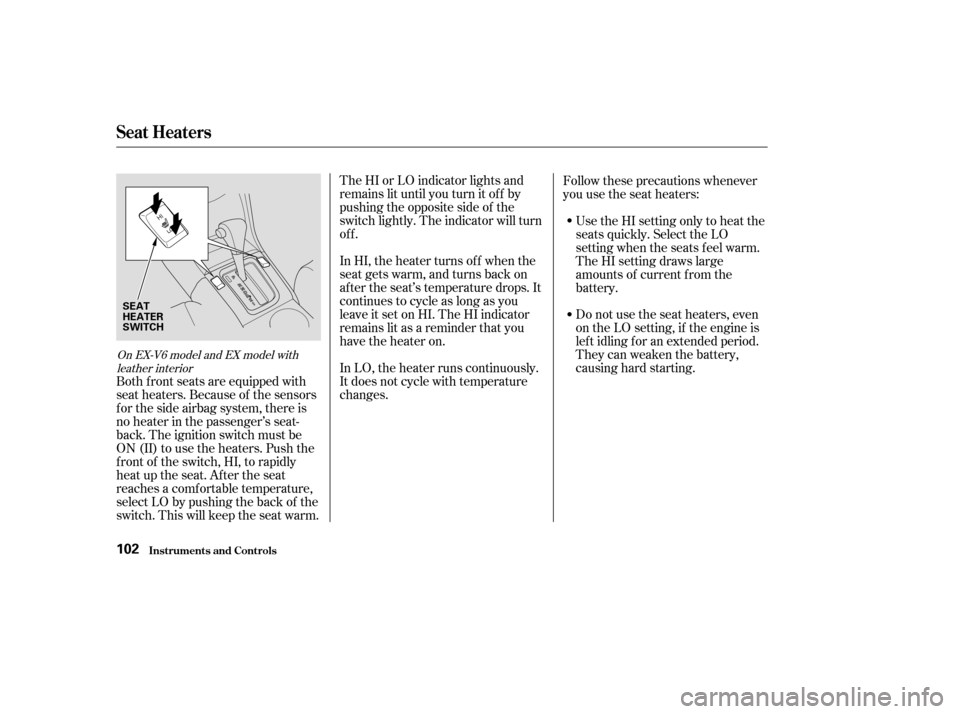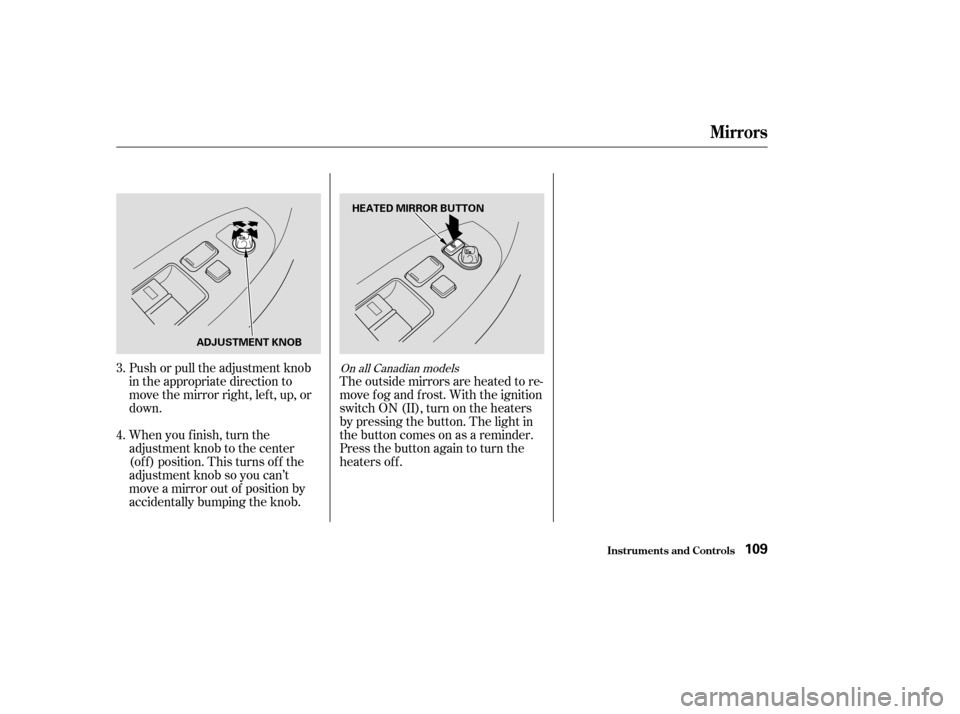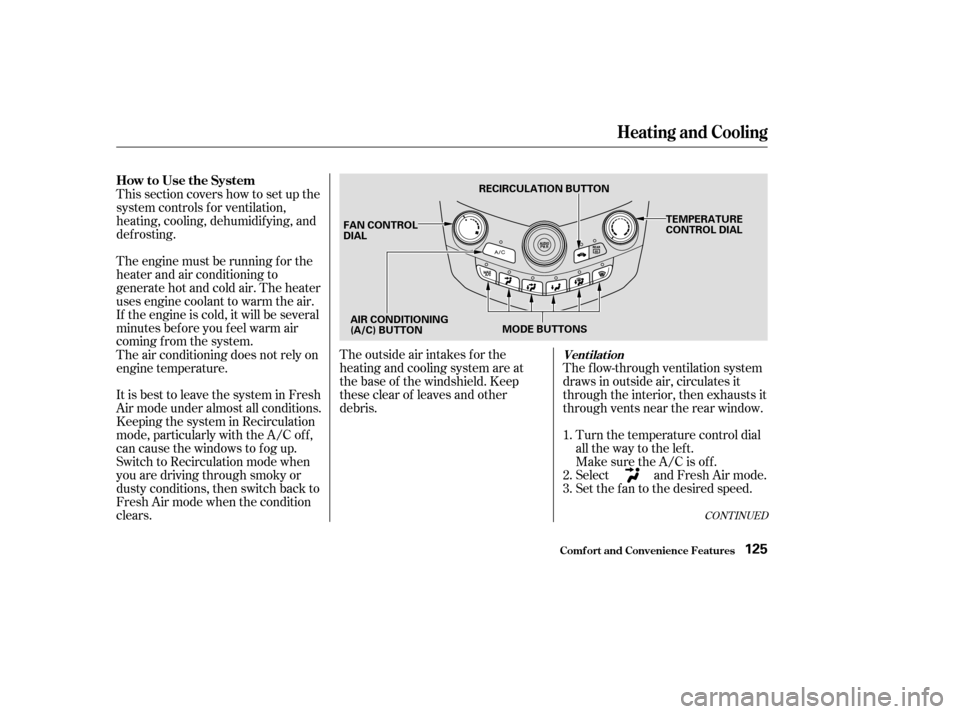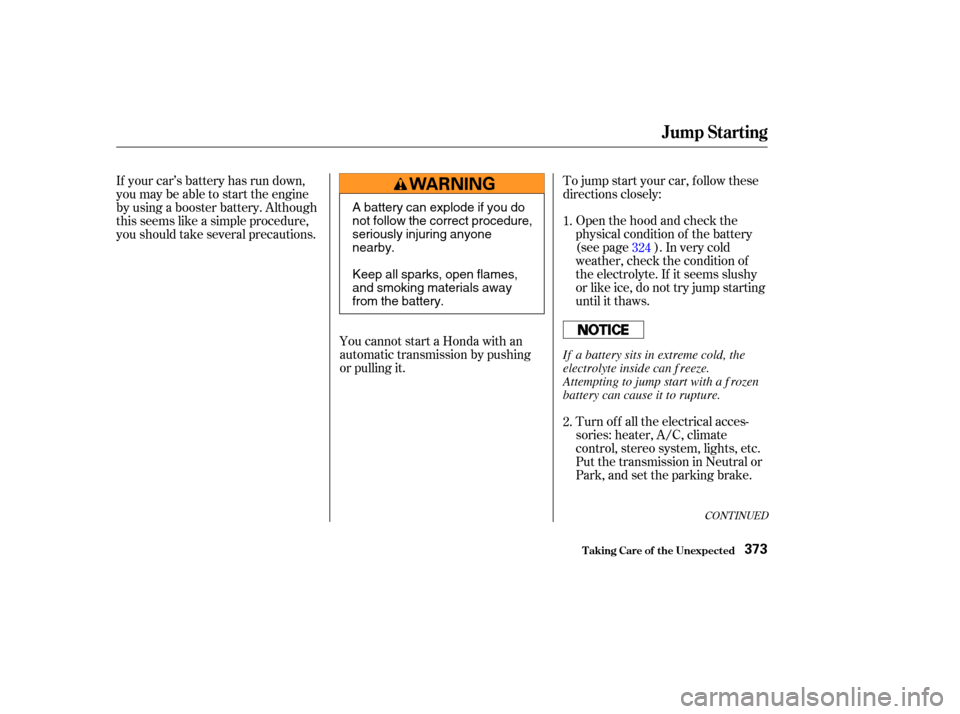2003 HONDA ACCORD COUPE heater
[x] Cancel search: heaterPage 62 of 429

This section gives inf ormation about
the controls and displays that
contribute to the daily operation of
your Honda. All the essential
controls are within easy reach............................
Control Locations .60
...............................
Indicator Lights .61
.............................................
Gauges .68
...............................
Speedometer .68
.................................
Tachometer .68
.....................................
Odometer .69
Outside Temperature ...................................
Indicator .69
...................................
Trip Meter .70
...................
Temperature Gauge . 70
..................................
Fuel Gauge .70
Maintenance Required ...................................
Indicator .71
Controls Near the Steering .......................................
Wheel .73
...................................
Headlights .74 Automatic Lighting Off
.....................................
Feature .75
............
Daytime Running Lights . 76
....
Instrument Panel Brightness . 76
................................
Turn Signals .77
.....................
Windshield Wipers .77
..................
Windshield Washers . 79
..........................
Hazard Warning .79
.............
Rear Window Def ogger . 79
......
Steering Wheel Adjustment . 80
...............................
Keys and Locks .82
..............................................
Keys .82
....................
Immobilizer System . 83
............................
Ignition Switch .84
......................
Power Door Locks .86
...................
Remote Transmitter . 87
...........................................
Trunk .91
........
Emergency Trunk Opener . 92
....................................
Glove Box .93
............................
Seat Adjustments .94
.............
Front Seat Adjustments . 94
Driver’s Seat Manual Height ..............................
Adjustment .95
Driver’s Seat Power Height ..............................
Adjustment .95 Driver’s Seat Power
............................
Adjustments .96
...........
Driver’s Lumbar Support . 97
........................
Rear Seat Access .98
..........................
Head Restraints .99
.....................
Folding Rear Seat .100
..................................
Seat Heaters .102
............................
Power Windows .103
.......................................
Moonroof .107
...........................................
Mirrors .108
..
Adjusting the Power Mirrors . 108
...............................
Parking Brake .110
.................
Console Compartment . 111
..........................................
Armrest .111
.........................
Beverage Holders .112
.........................
Center CD Pocket .113
...................................
Coin Pocket .113
........................................
Sun Visor .114
................................
Vanity Mirror .115
......................................
Coat Hook .115
........................
Sunglasses Holder .116
............
Accessory Power Sockets . 116
...............................
Interior Lights .117
..............................
Ceiling Light .117
...................................
Spotlights .118
........................
Courtesy Lights .119
Instruments and Controls
Inst rument s and Cont rols59
Page 105 of 429

The HI or LO indicator lights and
remains lit until you turn it of f by
pushing the opposite side of the
switch lightly. The indicator will turn
off.
In HI, the heater turns of f when the
seat gets warm, and turns back on
after the seat’s temperature drops. It
continues to cycle as long as you
leave it set on HI. The HI indicator
remains lit as a reminder that you
have the heater on.
In LO, the heater runs continuously.
It does not cycle with temperature
changes.Do not use the seat heaters, even
on the LO setting, if the engine is
lef t idling f or an extended period.
They can weaken the battery,
causing hard starting. Use the HI setting only to heat the
seats quickly. Select the LO
setting when the seats f eel warm.
The HI setting draws large
amounts of current f rom the
battery.
Follow these precautions whenever
you use the seat heaters:
Both f ront seats are equipped with
seat heaters. Because of the sensors
f or the side airbag system, there is
no heater in the passenger’s seat-
back. The ignition switch must be
ON (II) to use the heaters. Push the
f ront of the switch, HI, to rapidly
heat up the seat. After the seat
reaches a comf ortable temperature,
select LO by pushing the back of the
switch. This will keep the seat warm.
On EX-V6 model and EX model with leather interior
Seat Heaters
Inst rument s and Cont rols102
SEAT
HEATER
SWITCH
Page 112 of 429

Push or pull the adjustment knob
in the appropriate direction to
move the mirror right, left, up, or
down.
When you f inish, turn the
adjustment knob to the center
(of f ) position. This turns of f the
adjustment knob so you can’t
move a mirror out of position by
accidentally bumping the knob.The outside mirrors are heated to re-
move fog and frost. With the ignition
switchON(II),turnontheheaters
by pressing the button. The light in
the button comes on as a reminder.
Press the button again to turn the
heaters off.
3.
4.On all Canadian models
Mirrors
Inst rument s and Cont rols109
HEATED MIRROR BUTTON
ADJUSTMENT KNOB
Page 128 of 429

CONT INUED
The f low-through ventilation system
draws in outside air, circulates it
through the interior, then exhausts it
through vents near the rear window.Turn the temperature control dial
all the way to the lef t.
Make sure the A/C is of f .
Select and Fresh Air mode.
Set the f an to the desired speed.
The outside air intakes f or the
heating and cooling system are at
the base of the windshield. Keep
these clear of leaves and other
debris.
This section covers how to set up the
system controls f or ventilation,
heating, cooling, dehumidif ying, and
def rosting.
The engine must be running f or the
heater and air conditioning to
generate hot and cold air. The heater
uses engine coolant to warm the air.
If the engine is cold, it will be several
minutes bef ore you f eel warm air
coming from the system.
It is best to leave the system in Fresh
Air mode under almost all conditions.
Keeping the system in Recirculation
mode, particularly with the A/C of f ,
can cause the windows to fog up.
Switch to Recirculation mode when
you are driving through smoky or
dusty conditions, then switch back to
Fresh Air mode when the condition
clears. The air conditioning does not rely on
engine temperature.
1.
2.
3.
Heating and Cooling
Comf ort and Convenience Feat ures
Vent ilat ion
How to Use the System
125
RECIRCULATION BUTTONTEMPERATURE
CONTROL DIAL
FAN CONTROL
DIAL
AIR CONDITIONING
(A/C) BUTTON MODE BUTTONS
Page 130 of 429

Air conditioning, as it cools, removes
moisture from the air. When used in
combination with the heater, it
makes the interior warm and dry.To remove f og f rom the inside of the
windows:
Set the f an to the desired speed.
Turn on the air conditioning.
Select and Fresh Air mode.
Adjust the temperature control
dial so the mixture of heated and
cooled air f eels comf ortable.
Once the engine is warmed up, this
setting is suitable f or all driving
conditions. Set the f an to the desired speed.
Select .
When you select , the
system automatically switches to
Fresh Air mode and turns on the
A/C. (The indicator above the
A/C button stays off.)
Adjust the temperature control
dial so the air flow from the
def roster vents f eels warm.
Turn on the rear window def ogger
to help clear the rear window.
When you switch to another mode
f rom , the A/C turns of f .
Butifitwasontostartwith,it
stays on.
Air conditioning places an extra load
on the engine. Watch the engine
coolant temperature gauge (see page
) when driving in stop-and-go
traf f ic or climbing a long, steep hill.
If it moves near the red zone, turn
of f the A/C until the gauge reads
normally.
To warm the interior:
Start the engine.
Select .
When you select , the
system automatically switches to
Fresh Air mode.
Set the f an to the desired speed.
Adjust the warmth of the air with
the temperature control dial. 1.
2.
3.
4.
1.
2.
3.
4.
1.
2.
3.
4. 70
CONT INUED
Heating and Cooling
Comf ort and Convenience Feat ures
T o Heat and Dehumidif y wit h A ir
Condit ioning T o Def og and Def rost
To Heat
127
Page 135 of 429

You can manually select various
f unctions of the Climate Control
system when it is in f ully automatic
mode. All other f eatures remain auto-
matically controlled. Making any
manual selection causes the word
AUTO in the display to go out.
Press the A/C button to turn the air
conditioningonandoff.Youwillsee
A/C ON or A/C OFF in the display.This button controls the source of air
going into the system. When the
indicator in this button is lit, air f rom
the car’s interior is sent through the
system again (Recirculation mode).
When the indicator is off, air is
brought in f rom outside the car
(Fresh Air mode).
You can, f or example, manually put
the system in recirculation mode
when driving through an area of
smoke or f umes.
When you turn the A/C of f , the sys-
tem cannot regulate the inside tem-
perature if you set the dial below the
outside temperature. With the A/C
of f , use the temperature control dial
to adjust the temperature of the air
flow to a comfortable setting.
When you set the temperature to its
lower limit ‘‘ ’’ or its upper
limit ‘‘ ’’, the system runs at
f ull cooling or heating only. It does
not regulate the interior temperature.
In cold weather, the f an will not
come on automatically until the car
has been driven f or a short time and
the heater starts to develop warm air.
Pressing the OFF button shuts the
climate control system completely
off. No air flow can cause the
windows to fog up. It is
recommended that you keep the f an
on at all times so stale air and
moisture do not build up in the
interior and cause f ogging.
Climat e Cont rol Syst em
Comf ort and Convenience Feat ures
Semi-automatic Operation
A ir Condit ioning (A /C) But t on
Recirculat ion But t on
132
Page 142 of 429

You can manually select various
f unctions of the Climate Control
system when it is in f ully automatic
mode. All other f eatures remain
automatically controlled. Some of
these functions appear in the
Navigation System display. Press the
A/C button next to the display to
show these functions. Making any
manual selection causes the
indicator in the AUTO button to go
out.
Pressing the OFF button shuts the
climate control system completely
off. No air flow can cause the
windows to fog up. It is
recommended that you keep the f an
on at all times so stale air and
moisture do not build up in the
interior and cause f ogging.
When you set the temperature to its
lower limit ‘‘ ’’ or its upper
limit ‘‘ ’’, the system runs at
f ull cooling or heating only. It does
not regulate the interior temperature.
In cold weather, the f an will not
come on automatically until the car
has been driven f or a short time and
the heater starts to develop warm air.
CONT INUED
Climat e Cont rol Syst em
Comf ort and Convenience Feat ures
Semi-automatic Operation
139
Page 376 of 429

Put the transmission in Neutral or
Park, and set the parking brake. Open the hood and check the
physical condition of the battery
(see page ). In very cold
weather, check the condition of
the electrolyte. If it seems slushy
or like ice, do not try jump starting
until it thaws.
To jump start your car, f ollow these
directions closely:
If your car’s battery has run down,
you may be able to start the engine
by using a booster battery. Although
this seems like a simple procedure,
you should take several precautions.
You cannot start a Honda with an
automatic transmission by pushing
or pulling it. Turn of f all the electrical acces-
sories: heater, A/C, climate
control, stereo system, lights, etc.
1.
2.
324
CONT INUED
Jump Starting
T aking Care of t he Unexpect ed373
A battery can explode if you do
not follow the correct procedure,
seriously injuring anyone
nearby.
Keep all sparks, open flames,
and smoking materials away
from the battery.
If a battery sits in extreme cold, the
electrolyte inside can f reeze.
Attempting to jump start with a f rozen
battery can cause it to rupture.